Understanding the Floating Plastic Island's Impact
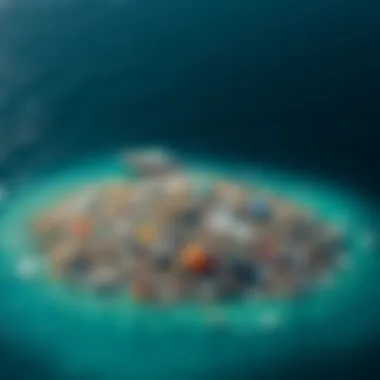
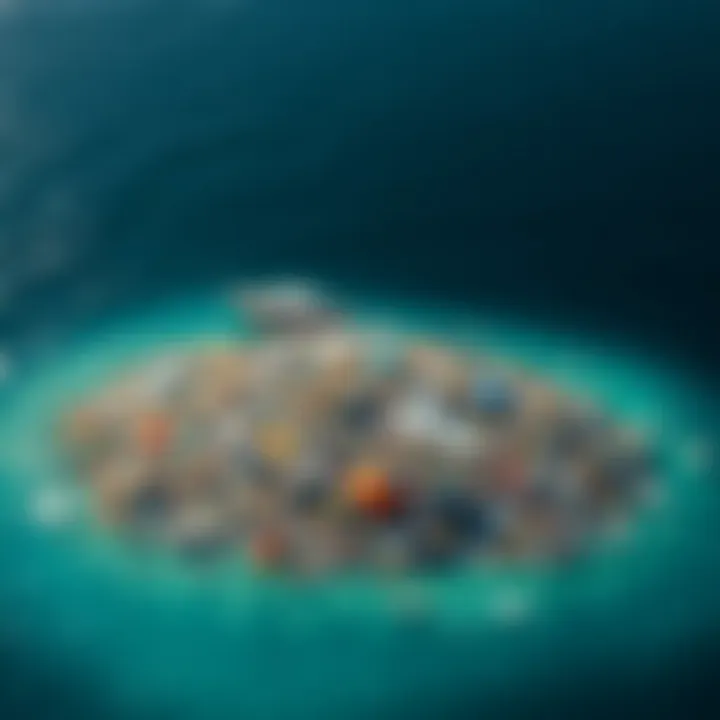
Intro
The Great Pacific Garbage Patch, often dubbed the floating plastic island, is a significant eye-opener on the global challenge we face regarding waste management and ocean health. This massive collection of rubbish is not just a sight for sore eyes; it also brings forth critical discussions about human impact on marine environments. From the everyday plastics we use to the other harmful items that end up in our oceans, understanding the scale and implications of this phenomenon is crucial.
With the rising tide of environmental consciousness, it is imperative to grasp how this patch came to be and why it matters. The questions surrounding its formation and what it represents are not trivial—these inquiries compel us to examine our habits, from consumer choices to plastic usage in our lives. Moreover, innovations designed to combat the issue reveal pathways to a cleaner future.
In this article, we will traverse through several dimensions of the Great Pacific Garbage Patch, shedding light on its size and formation, the dire environmental consequences, and the multi-faceted approaches being taken to mitigate this crisis. Our aim is to foster a deeper understanding of this pressing issue, encouraging proactive stewardship among readers and inspiring community-led initiatives.
Intro to the Floating Plastic Island
The phenomenon of the floating plastic island is not just an environmental concern; it is a complex issue that encompasses various elements affecting marine ecosystems, human health, and our understanding of oceanic pollution. The Great Pacific Garbage Patch, as it is formally known, is an awe-inspiring and alarming example of the consequences of our reliance on plastic in modern society. This section aims to establish the groundwork for comprehending the scope of this issue and highlights why it is pivotal for individuals, particularly those engaged in ocean-related activities like surfing, paddleboarding, and kitesurfing, to be aware of the implications of marine debris.
Defining the Great Pacific Garbage Patch
At its core, the Great Pacific Garbage Patch is a massive accumulation of oceanic waste primarily composed of plastics, located between Hawaii and California. It is important to understand that this patch is not a solid island; rather, it's a dispersal of minute plastic particles and debris that are concentrated by ocean currents, forming an extensive, diffuse area teeming with this waste. Official estimates suggest that the size ranges from about 1.6 million square kilometers to potentially three times that, depending on various factors, including ocean currents and weather conditions. Think of it as a chaotic whirlpool of floating waste, where bits of plastic are often barely visible to the naked eye, yet their impacts on marine life and ecosystems are nothing to ignore.
"The Great Pacific Garbage Patch is an atheistic reminder of our modern consumption patterns and their unforeseen repercussions."
With regard to surfers, paddleboarders, and kitesurfers, the quality of water in which they enjoy their sport is at stake. Awareness of the Great Pacific Garbage Patch can drive conversations around protective measures and foster a greater sense of responsibility toward our ocean environments.
Historical Context of Ocean Pollution
To fully grasp the gravity of the floating plastic island, one must take a step back in time. The roots of ocean pollution stretch back several decades, starting with the post-World War II boom in plastic production. Initially, plastics were marketed as a convenient and versatile solution, with promises of durability and low-cost. As industries embraced plastic, a throwaway culture emerged, encouraging consumers to prioritize convenience over environmental impact. The result? Millions of tons of plastic waste that often end up in the oceans, where marine wildlife encounters these harmful materials.
The 1970s marked a pivotal moment when awareness about ocean pollution began to take shape. Campaigns against littering gained traction, yet the most impactful movements came later. Initiatives like the Marine Protection, Research, and Sanctuaries Act in the United States in the 1980s sought to address issues tied to ocean dumping. However, despite these efforts, each passing decade has seen a rise in plastic production, and thus, plastic pollution. We find ourselves in a situation where past generations' lack of accountability now burdens current and future ones.
For outdoor enthusiasts, understanding the historical context is critical. It emphasizes the long-standing disregard for how our consumption habits directly contribute to the current state of our oceans. The more aware individuals become of this legacy, the more likely they are to take action—be it through advocacy, education, or simply adjusting their own waste management practices.
As we continue our exploration into the dimensions, composition, and formation of the plastic island, it becomes increasingly clear that this is not merely an environmental challenge; it's an invitation to rethink our relationship with plastic and the oceans.
Dimensions of the Floating Plastic Island
Discussing the dimensions of the Great Pacific Garbage Patch sheds light on the magnitude of the global plastic pollution crisis. Understanding how vast this floating island is may spur a sense of urgency among outdoor enthusiasts, such as surfers and paddleboarders, who are directly affected by ocean health.
The floating plastic island isn't just a pile of trash; it’s an evolving ecosystem of pollution that threatens marine environments and those who interact with them. Exploring its dimensions not only highlights the enormity of the problem but also emphasizes the need for substantial collective action to address it. Moreover, it offers a chance to reflect on our personal responsibility in the solutions.
Current Estimates of Size
Recent estimates indicate that the Great Pacific Garbage Patch spans approximately 1.6 million square kilometers, a stretch larger than the state of Texas. Some researchers argue that it could even be twice that size when factoring in the dispersed microplastics that lie beneath the surface. This statistic isn’t just a number. It’s a startling visual representation of wasted resources and damaged ecosystems.
The bulk of this patch is made up of not just large pieces of plastic but tiny fragments that break down over time. Here’s the kicker: it's estimated that around 80,000 tons of plastic debris float in these waters today. That’s akin to having nearly six times the weight of a giant whale dispersed across the ocean.
"The scale of the plastic being found can be eye-opening; every breath in the ocean seems to carry traces of human-made materials," noted environmental researchers observing these formations.
Comparison with Land Masses
When we draw comparisons between the Great Pacific Garbage Patch and familiar land masses, the sheer size becomes starkly evident. For reference, it’s roughly the same area as the combined size of the states of Hawaii and New Jersey or even more interestingly, close to that of the United Kingdom. If you were to look at it from a distance, it might easily be mistaken for an island, but instead of lush greenery, it’s chock-full of debris.
This highlights a crucial point for visitors to our beaches or those enjoying ocean sports: the waters where many recreational activities take place are directly affected by this pollution. The next time a surfer catches a wave, it's not just about riding the swell; it’s also about the potential encounter with debris.
While these figures may feel overwhelming, they should serve as catalysts for proactive measures. Engaging with this information allows individuals to reconsider their habits and spread awareness within their communities.
By melding ocean exploration with ecological responsibility, surfers and water sports enthusiasts can lead the charge in advocating for cleaner oceans.
Composition of the Garbage Patch
Understanding the composition of the garbage patch provides essential insights into both its formation and environmental consequences. The various types of materials that have accumulated not only reveal the scale of pollution but also give us clues on how to address the issue effectively. Given the diverse origins of the debris, recognizing its compound nature can catalyze better mitigation strategies. Indeed, comprehending this composition is like looking at a puzzle—every piece contributes to the larger picture of environmental impact, human health, and marine biodiversity.
Types of Plastic Materials
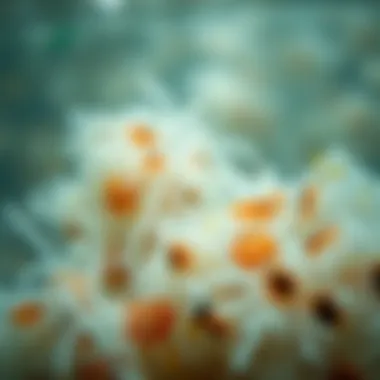
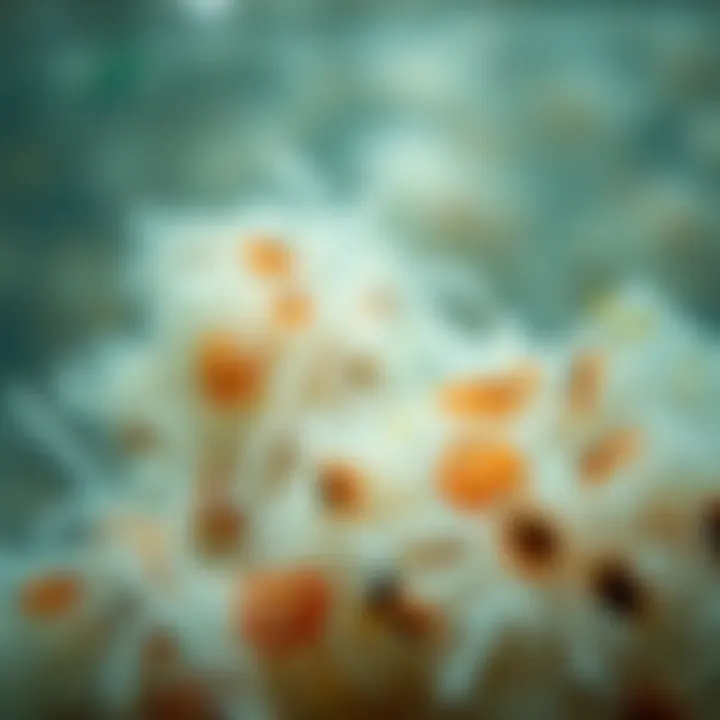
The garbage patch is predominantly made up of plastic materials, which come in many forms. Here are some common types:
- PET (Polyethylene Terephthalate): Often found in drink bottles and food containers, PET can break down into microplastics over time.
- HDPE (High-Density Polyethylene): Commonly used in containers like milk jugs and detergent bottles, it forms a significant part of the floating debris.
- Polystyrene: Known for its use in foam packaging and disposable cups, polystyrene is notorious for its inability to biodegrade, leading to long-lasting pollution.
- PVC (Polyvinyl Chloride): Used in plumbing pipes and vinyl flooring, PVC can leach toxic chemicals into the ocean.
- Polypropylene: This plastic is present in items like straws and food containers, and its durability contributes to the patch's persistence in marine habitats.
The mixture of these plastics presents unique challenges. Some materials are more likely to fragment into microplastics than others. Additionally, the pigments, additives, and contaminants that accompany these products can pose further risks to ocean life.
Microplastics and Their Impact
Microplastics are tiny plastic particles, usually less than five millimeters in size. They refine our understanding of the garbage patch’s environmental impact considerably. Microplastics primarily originate from:
- Larger Plastic Debris: As larger plastic items succumb to weathering, UV exposure, and physical abrasion, they break down into these tiny particles.
- Synthetic Textiles: Washing synthetic fabrics releases microplastics into wastewater systems, which can eventually reach the ocean.
- Cosmetics and Personal Care Products: Microbeads used in scrubs and toothpaste contribute to aquatic pollution when washed down the drain.
The ecological effects of microplastics are worrisome. Marine life, from tiny plankton to larger fish, can ingest these particles, mistaking them for food. This ingestion can lead to:
- Bioaccumulation: Small organisms consume microplastics, and as predators eat these organisms, toxins can move up the food chain, eventually reaching humans.
- Physical Harm: Creatures that ingest microplastics may experience internal damage, reproductive issues, and even death.
- Chemical Contaminants: Microplastics can attract and carry harmful chemicals, increasing the toxicity of marine environments.
"In the grand scheme, each piece of plastic contributes to an intricate, sometimes devastating web of impact. Once in the ocean, we’re just beginning to understand the extent of that reach."
The composition of the Great Pacific Garbage Patch reveals not only the scale of human negligence but also provides insights into potential solutions. Addressing the sources and impacts of these materials is essential for protecting the oceanic ecosystem and, ultimately, human health. For more detailed information, consider visiting National Oceanic and Atmospheric Administration or browsing comprehensive studies on Britannica.
Engaging in remediation efforts requires an understanding of what we’re dealing with—knowing what floats out there is the first step towards making a difference.
Formation of the Garbage Patch
Understanding the formation of the Floating Plastic Island is crucial in grasping the magnitude of the environmental crisis it represents. A comprehensive look at how these vast expanses of plastic accumulate can raise awareness about the interconnectedness of human activities and marine ecosystems. This section aims to explain the pivotal elements contributing to the Garbage Patch's formation, underscore its significance for marine health, and highlight considerations that those deeply engaged in water sports, like surfers and kitesurfers, should pay heed to.
Ocean Currents and Their Role
Ocean currents play a fundamental part in the genesis of the Great Pacific Garbage Patch. These currents are like highways in the ocean, guiding every piece of debris on their path. The North Pacific Gyre, for instance, is a massive rotating system of ocean currents where plastic waste tends to cluster.
- Gyres and their Dynamics: The movement of water in these gyres creates zones known as convergence zones, where debris naturally accumulates. This is why much of the plastic that ends up in the ocean is not just scattered; it gravitates toward these convergence zones. Surfing or paddleboarding near these areas can pose risks if one is unaware of their proximity to such hotspots.
- Current Patterns Specifically: The agility of wind-driven currents combined with the deeper ocean currents ensures that plastic waste remains entrapped. The circular motion causes debris to be trapped in a relatively static area, which effectively becomes a dumping ground for the existing plastic waste. It is essential for surfers and kitesurfers to remember how currents can change between seasons and how this might affect waste movement.
The Accumulation Process
The process of accumulation in the Great Pacific Garbage Patch is not a matter of merely tossing items into the sea. It is a slow, continuous process, often invisible to those enjoying the oceans. The accumulation happens in three principal phases:
- Initial Entry: Plastics enter the ocean from rivers, harbors, and urban runoff. Essentially, any plastic product that is not disposed of correctly has the potential to become oceanic debris.
- Fragmentation: Once in the ocean, the plastics don’t just float indefinitely in their original form. Over time, UV radiation and the mechanical forces of the ocean break them down into smaller pieces called microplastics. These tiny pieces are particularly concerning as they are often mistaken for food by marine wildlife.
- Long-term Trapping: Microplastics don't break down easily. They can remain in the water for years, if not decades, accumulating within the gyre. It's believed that a significant proportion of the marine life in the vicinity of the Garbage Patch can be affected, ultimately influencing the entire food chain.
"The accumulation of plastic in our oceans is not just a problem for marine life; it's a matter of human responsibility as the effects of our actions ripple throughout the ecosystem."
The understanding of how the Garbage Patch forms and grows is vital for surfers, instructors, and gear reviewers who frequently engage in marine environments. By recognizing this cycle, they can enhance their awareness and contribute to conversations around sustainability. Awareness can lead to actionable changes in habits and practices that ultimately benefit ocean conservation efforts.
Environmental Consequences
The floating plastic island, often shadowed in our daily lives, holds repercussions that extend far beyond the eye. The environmental consequences of the Great Pacific Garbage Patch pose serious threats to marine ecosystems and human health. This section uncovers how the accumulation of plastic affects marine wildlife and the people who depend on these vast waters, emphasizing the interconnectedness of life and the ripple effects of neglecting the oceans.
Effects on Marine Wildlife
When considering the effects on marine wildlife, the profound implications of plastic pollution come into focus. Marine creatures, from the tiniest plankton to the largest whales, struggle to navigate an ocean that’s become the hiding place for our discarded waste. Their survival and wellbeing are intimately tied to the cleanliness of our waters.
Entanglement
Entanglement in plastic is a tragic reality for many marine species. Animals such as seals, sea turtles, and even dolphins can get trapped in abandoned fishing gear, nets, or plastic debris. This entanglement not only restricts their movement but can also lead to severe injuries or death. What’s central here is the fact that entangled animals suffer immense stress, and their chances of survival diminish. Furthermore, this creates a ripple effect; if predators or competitors are impacted, it shifts the entire marine food web. The unique characteristic of entanglement lies in how it ruthlessly exemplifies the growing disconnect between human activity and marine life.
Ingestion
Ingestion of plastic is another staggering consequence. Many marine animals mistake plastic for food. For instance, seabirds often gobble down tiny bits of plastic, thinking they are fish or other nutritious prey. The key characteristic of ingestion is the harmful substances that plastics release, like toxic chemicals and pollutants, which can bioaccumulate in the food chain. For marine life, this can lead to malnutrition or poisoning. A major disadvantage here is that once ingested, the plastic might stay trapped in the animal's stomach, which can lead to death, and ultimately impact the entire ecosystem.
Habitat Destruction
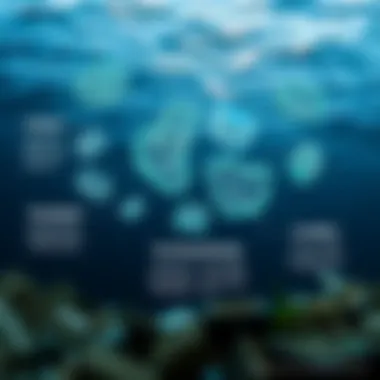
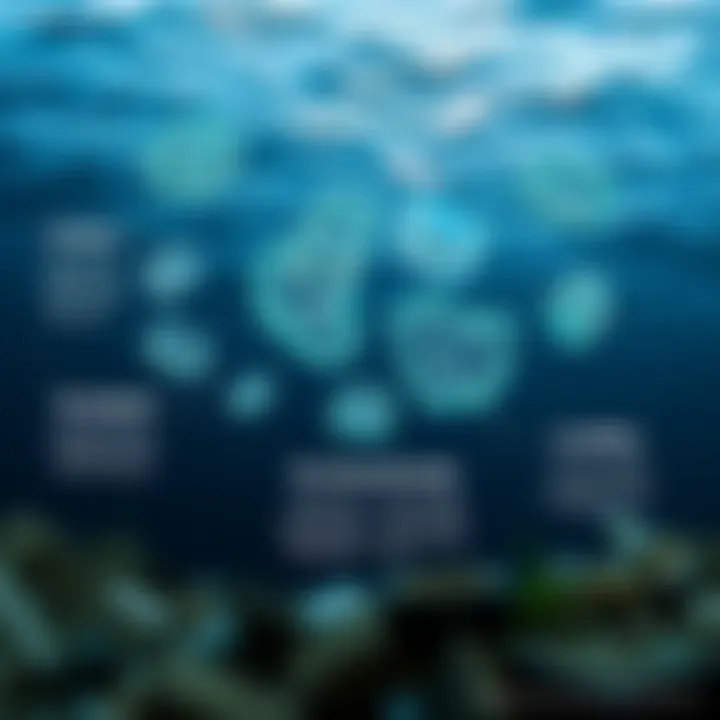
Habitat destruction through plastic pollution can be silent yet devastating. Coral reefs, crucial for marine biodiversity, face increasing threats from plastic debris. The key aspect of habitat destruction is how plastics can smother coral, blocking sunlight necessary for photosynthesis and disrupting habitats for countless species. Further, the fragile balance of these ecosystems becomes unhinged, often leading to mass die-offs. The irony here is stark: while plastic might seem insignificant, its ramifications on marine habitats are far-reaching, affecting not just one species, but an entire community of life beneath the waves.
Impact on Human Health
Shifting the focus back to our interaction with these aquatic environments, we must turn our attention to the impact on human health. The effects of pollution are not confined to the sea; they inevitably return to us, often through food sources and water quality.
Toxins in Food Chain
Toxins in the food chain are a critical concern when discussing human health. As microplastics infiltrate marine organisms, they can accumulate harmful substances like heavy metals and persistent organic pollutants. One key point is the bioaccumulation that occurs when smaller fish consume these contaminated organisms, leading to larger fish and, eventually, to us. Consuming seafood that contains these toxins can lead to serious health problems, including hormonal disruptions and cancers. The unique feature of this cycle is that it serves as a reflection of our choices and their consequences. This highlights the importance of food safety standards and regulations.
Human Consumption Risks
Human consumption risks associated with plastic pollution are often overlooked but should take center stage. From the fish we eat to drinking water potentially tainted with microplastics, the dangers loom large. The most alarming aspect here is the unknown long-term effects of consuming pollutants that we can’t always detect. While some might argue that the risks are manageable, as more research emerges, the implications could be more severe than previously thought. As fishermen and communities that rely on these bodies of water, we bear the weight of the responsibility to ensure the health of marine life not just for them, but for our sake as well.
"Environmental health is the ultimate health. If we poison our environment, we poison ourselves."
Understanding these consequences serves as a vital reminder that the pathways of pollution are interconnected. From entangled sea creatures to the toxins that can dwell in our meals, the implications are real and pressing. Addressing these issues isn’t merely a choice; it’s a necessity for the sustainability of our ecosystems and our own existence.
Mitigation Strategies
Mitigating the impact of the floating plastic island, known as the Great Pacific Garbage Patch, is critical to preserving marine ecosystems and promoting sustainability. The challenges associated with plastic pollution are multifaceted, requiring coordinated efforts involving non-profit organizations, government agencies, and innovative technologies. Understanding these strategies can spur action and awareness, fostering a culture of environmental responsibility among different communities.
Clean-Up Initiatives
Non-profit Projects
Non-profit initiatives play a pivotal role in combating plastic pollution. These organizations often operate on limited budgets yet manage to make significant strides due to grassroots support and community involvement. A prominent example is the Ocean Cleanup Initiative, which employs advanced technologies and a determined volunteer base to remove debris from the ocean.
The key characteristic of non-profit projects is their ability to mobilize local communities. When people feel they have a stake in the cleanup, they engage more deeply. These projects often raise awareness about the consequences of plastic pollution, encouraging people to adopt eco-friendly habits.
What’s unique about these initiatives is their focus on education and prevention. They do not solely emphasize cleanup but also aim to educate the public. However, limited funding can hinder their reach and effectiveness. They can struggle with scaling operations, particularly on a global scale where resources are vast.
Government Agencies
Government agencies also have a crucial role in addressing the plastic crisis. By creating policies that regulate waste management and promote sustainable practices, governmental bodies can drive systemic change. For instance, the Environmental Protection Agency (EPA) in the United States actively works on regulations to limit plastic waste.
The key characteristic of these agencies is their capacity to enact laws and allocate funding for large-scale initiatives. Unlike non-profits, they can spearhead comprehensive policies that hold corporations accountable for their waste. This helps foster a culture of responsibility among major polluters.
What stands out is the unique feature of federal and state programs providing solid infrastructure for waste management. On the downside, bureaucratic processes can lead to delays in implementing important measures, hindering timely responses to the escalating plastic crisis.
Innovations in Waste Management
Recycling Technologies
Innovations in recycling technologies represent a vital aspect of waste management. State-of-the-art methods, like chemical recycling, can convert plastics back into their raw materials. This allows for a closed-loop system where materials are reused rather than discarded.
The key characteristic of these technologies is their potential to reduce the amount of plastic waste that ends up in the oceans. Chemical recycling, for example, can handle mixed plastics that traditional recycling might reject. Consequently, they can greatly increase recycling rates and lower environmental impact.
Despite these benefits, challenges remain. The adoption of new recycling technologies often requires significant investment and research, which not all countries or companies are willing to make. Additionally, the technology's effectiveness can vary based on the type of plastic processed.
Biodegradable Alternatives
The push for biodegradable alternatives is gaining traction as public awareness of plastic pollution grows. These materials are designed to break down more naturally in the environment, easing the burden on waste management.
One of the key characteristics of biodegradable alternatives is their potential to substitute traditional plastics in everyday products, like packaging and bags. This means that consumers can use items without worrying that they might persist in the environment for centuries.
However, the unique feature of such alternatives is their dependence on specific conditions for degradation—much depends on the environment in which they find themselves. This brings about advantages but also highlights the disadvantage of requiring proper disposal facilities to ensure effectiveness.
"Mitigation strategies are crucial to combatting the floating plastic island, as they integrate community action, governmental support, and innovative technology into one cohesive front against pollution."
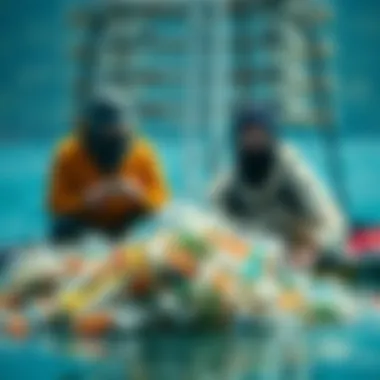
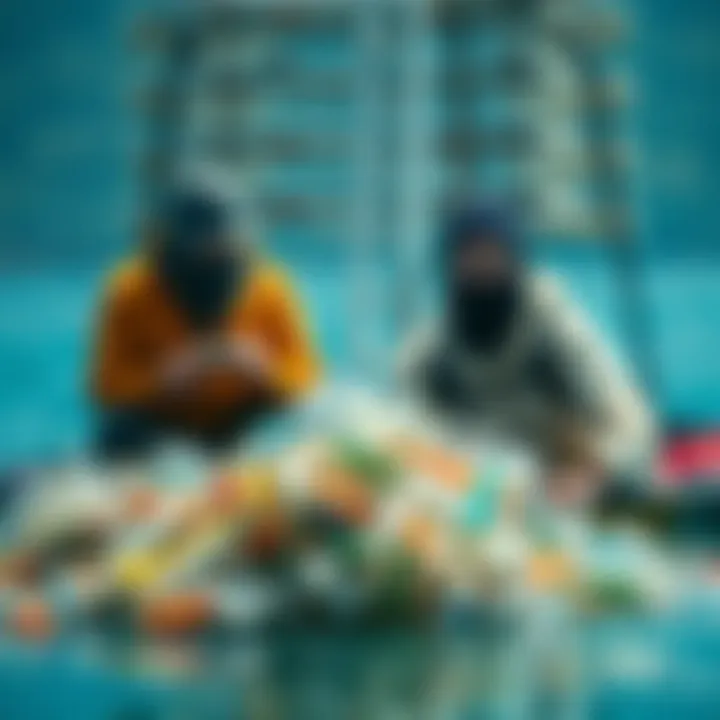
Overall, addressing the floating plastic island involves a multi-pronged approach. Combining efforts from non-profits, government agencies, recycling technologies, and biodegradable alternatives offers hope in tackling this pressing environmental challenge.
The Role of Legislation
Legislation plays a pivotal role in tackling ocean pollution, particularly the floating plastic island known as the Great Pacific Garbage Patch. Without a robust framework guiding conversion on the issue, efforts toward sustainability can easily fall by the wayside. Importantly, laws and regulations can incentivize change, guiding industries and communities toward reducing plastic use and managing waste efficiently. By implementing effective legislation, we can align stakeholders—from government entities to local businesses—behind comprehensive, impactful solutions.
International Agreements and Treaties
International agreements on plastic pollution have become crucial in the global fight against marine debris. The United Nations has taken steps to address this pressing issue by initiating treaties such as the Basel Convention, which aims to reduce the movement of hazardous waste. While this treaty primarily focuses on dangerous waste, it has a ripple effect on plastic waste prevention efforts worldwide.
Moreover, the Montreal Protocol serves as a strong example of how collective action can lead to positive environmental outcomes. Established to phase out substances that deplete the ozone layer, it demonstrates that coordinated international action can lead to substantial change. In tandem, similar frameworks focusing on reducing single-use plastics around the globe need urgent attention.
"What unites us is far more powerful than the forces that divide us." - Ban Ki-moon
Legislation such as the Global Plastic Accord seeks to unify countries under a common goal. This potential treaty could create binding agreements on plastic reduction targets, waste management, and recycling. Awareness is growing about the need to address the pollution crisis together, highlighting that a collaborative approach could have higher success rates.
National Policies on Plastic Use
On the national level, various countries are implementing policies that target plastic waste and its devastating effects on marine ecosystems. For instance, France has taken a bold step by banning plastic bags in grocery stores, showcasing how a policy can effectively mitigate plastic consumption at the source. Similarly, Canada is gearing up to ban single-use plastics by 2021, focusing on items like straws, stir sticks, and plastic cutlery. These national policies not only serve the purpose of reducing waste but also educate citizens on sustainable practices.
In the United States, individual states are beginning to take the initiative as well, with California leading the charge by enacting laws that regulate plastic use more strictly than federal guidelines. The California SB 54 and AB 1080 legislation aims for zero waste by 2030, emphasizing the lifecycle of materials and promoting recycling practices. This ensures that the responsibility does not solely lie with consumers but also with manufacturers to rethink their production methods.
Incorporating these legislative measures requires comprehensive support systems—public funding for alternatives, education on environmental impacts, and community initiatives that engage citizens in clean-up activities.
Through these various layers of legislation, whether it’s international agreements or national policies, we can construct a multi-faceted approach to essentially diminish the floating plastic island. Evidence shows that when clear laws are in place, progress can be made. As surfers, paddleboarders, kitesurfers, and instructors all play a part in this narrative, supporting these legislative efforts can directly bolster healthier oceans and, by extension, protect the environments we love.
The Path Forward
Tackling the issue of plastic pollution, particularly the scale of the floating plastic island, is no small feat. Yet, it's crucial for the protection of marine ecosystems and human health. Understanding the path forward means recognizing our power as a collective force for change. Here, we will explore how community involvement and individual responsibility can pave the way for a cleaner, healthier ocean.
Community Engagement and Awareness
Community engagement is the heartbeat of any large-scale environmental initiative. When people come together for a common cause, they foster a sense of belonging and shared responsibility. In the case of the Great Pacific Garbage Patch, raising awareness and mobilizing local communities can lead to significant change.
- Education Programs: Schools, local governments, and NGOs can collaborate on workshops that educate residents about the sources and effects of plastic pollution. Engaging students, especially, can nurture a generation that cares deeply about the ocean.
- Community Clean-Up Events: Organizing beach clean-up days isn't just about picking up trash; it’s about gathering community members and creating visual impact. Each ounce of plastic removed serves as a reminder of what individuals can accomplish together.
- Social Media Campaigns: Utilizing platforms like Facebook or Reddit to spread the word can galvanize even those who may not be directly engaged. Sharing stories and statistics can inspire others to join the movement.
A pivotal part of community awareness is establishing partnerships with local surf shops, paddleboard schools, and kitesurfing clubs. These businesses often have the trust and respect of local enthusiasts, making them ideal messengers for environmental initiatives. By promoting sustainable practices and highlighting their existence, they can make waves of positive change.
Individual Actions and Responsibility
While collective action is powerful, individual contributions matter immensely. Each person has the capacity to affect change, starting with their personal habits.
- Reduce and Reuse: Simple changes in daily life can unearth significant impacts. Using reusable water bottles, bags, and utensils not only cuts down on waste but sets a precedent for others.
- Support Sustainable Brands: Opting for products made with eco-friendly materials or brands that prioritize sustainability can encourage other businesses to follow suit. For those who are surfers or involved in water sports, choosing gear manufactured with environmentally safe practices is essential.
- Advocacy: Engage in conversations about plastic pollution within your community. Whether it's suggesting plastic-free alternatives at your local surf shop or participating in town hall discussions, speaking up adds weight to the cause.
Actively embracing sustainable habits fosters a culture of environmental stewardship. When individual actions align with community efforts, the impact can be seismic.
As challenging as the task may appear, with each small step taken on both community and individual fronts, we can work towards cleansing our oceans and ensuring healthy waters for generations to come.
Ending
Recap of Key Points
In reviewing the information throughout this article, several key elements have emerged:
- Size and Influence: The Great Pacific Garbage Patch isn’t just a small patch; it occupies vast stretches of ocean, larger than many countries. Understanding its size helps grasp its potential impact on marine life and human health.
- Composition Matters: A detailed exploration of the types of plastics showcases their lasting effects. From large fishing nets to microplastics, each element presents unique challenges that contribute to ecological degradation.
- Formation Dynamics: Ocean currents play a pivotal role in accumulating this debris. Recognizing the mechanisms of formation gives us insight into how we may address, or even prevent, future growth.
- Consequences: The ripple effects on wildlife and humans are profound. Entanglement and ingestion are grave threats to marine species, which can directly influence human food sources and health.
- Mitigation Efforts: Various clean-up initiatives and innovations in waste management are crucial steps being undertaken to combat the crisis. Community-driven actions could serve as a beacon of hope.
The Urgency of Action
Time is not on our side. The urgency of action against the floating plastic island cannot be overstated. We have reached a critical juncture; the acceleration of plastic production combined with a lack of adequate waste management systems threatens not just marine life, but our ecosystems as well. In the face of this growing challenge, we cannot afford to act slowly or passively. The longer we wait to address this issue directly, the more it compounds, creating a daunting legacy for future generations.
"If we don’t actively engage in solutions, we are allowing the very fabric of the marine world—and our own health—to unravel."
It's imperative that surfers, paddleboarders, kitesurfers, and their respective communities become proactive advocates. This extends beyond enjoying the waves; it includes protecting those very waters from becoming a plastic graveyard. By sharing knowledge, adopting sustainable practices, and supporting advocacy efforts, the collective voice can echo far beyond the surf breaks.
In sum, a comprehensive understanding of the scale of the Great Pacific Garbage Patch empowers us to act responsibly and make informed choices. Taking pride in our oceans today ensures that tomorrow's waves remain untainted, vibrant, and teeming with life.
For further reading, visit sources like Wikipedia and Britannica.
Stay informed, stay engaged, and let’s safeguard the blue heart of our planet.



